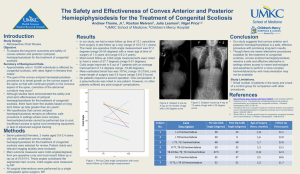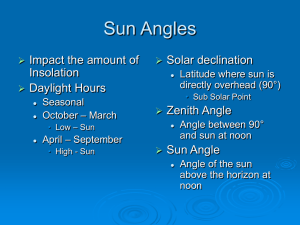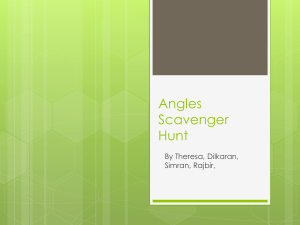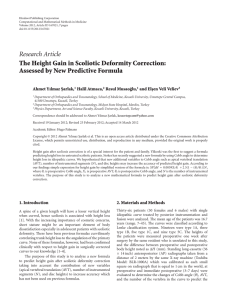op5.4 - csio
advertisement
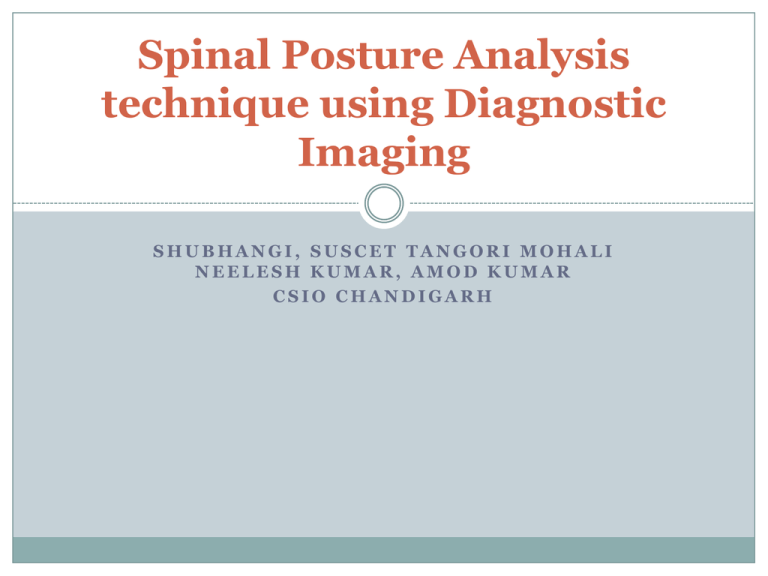
Spinal Posture Analysis technique using Diagnostic Imaging SHUBHANGI, SUSCET TANGORI MOHALI NEELESH KUMAR, AMOD KUMAR CSIO CHANDIGARH Diseases In today’s fast changing world and sedentary several new diseases are evolving. linked with improper posture of human. Diseases like Scoliosis low back pain, pelvic tilt, kyphosis and lordosis can be related to abnormal spine posture. Scoliosis Scoliosis is defined as curvature of the spine greater than 10 degrees, as measured on an X-ray. Anything less is simply due to normal variation. One shoulder may appear higher than the other. One hip may appear higher than the other. The child's head is not centered over his or her body. One shoulder blade may stick out more than the other. The ribs are higher on one side when the child bends forward from the waist. The waistline may be flat on one side. Scoliosis Diagnosis Diagnosis of any disease requires correct estimation of vital parameters. Diagnostic medical tests are further classified as imaging and non-imaging type. X-ray, Magnetic Resonance Imaging, Computed tomography, and Ultrasound Choice of particular technology is depends on the location, and required accuracy. Cost and availability are other important factors in developing countries Diagnosis X-ray is most widely used method for diagnosing orthopedic diseases. 80% of the diseases are diagnosed with X-ray. X-ray causes several side effects which are harmful to body, like excessive exposure to X-ray can cause skin cancer. Several technological limitation also, like the under or over exposure, quality of the film, developing material and also X-ray source’s life. Because of cheap test cost and widely availability these are used in developing countries. Examination Methods Shoulders are different heights—one shoulder blade is more prominent than the other Head is not centered directly above the pelvis Appearance of a raised, prominent hip Rib cages are at different heights Uneven waist Changes in look or texture of skin overlying the spine (dimples, hairy patches, color changes) Leaning of entire body to one side Examination Methods Adam's Forward Bend Test For this test, the patient is asked to lean forward with his or her feet together and bend 90 degrees at the waist. The examiner can then easily view from this angle any asymmetry of the trunk or any abnormal spinal curvatures. It should be noted that this is a simple screening test that can detect potential problems, but cannot determine accurately the exact severity of the deformity. Cobb angle Cobb's angle, a measurement used for evaluation of curves in scoliosis on an AP radiographic projection of the spine The angle between these two lines (or lines drawn perpendicular to them) is measured as the Cobb angle. Cobb angle Cobb's angle is found by measuring the angle of the two intersecting perpendicular lines. As a general rule a Cobb angle of 10 is regarded as a minimum angulations to define scoliosis. If the Cobb's angle for your scoliosis is 15 degrees or less, it's likely that all you will need are regular check-ups to see if the curve is progressing. If it is between 20 and 40 degrees, you will probably need a back brace. If it is over 40, your doctor will likely recommend surgery. Objective Authors conceptualize a novel method based on the diagnostic imaging to diagnose abnormal spine posture. The method is free from all limitation and harmful effect of X-ray examination and therefore can be done frequently. The 2D images of bare back are averaged and interpolated to reconstruct the patient spine. The 3D image data are analyzed over a software platform like LabVIEW and Matlab. This analysis can give the early estimation of abnormal posture related diseases. Estimation of Cobb Angle Pat 1 Pat 2 Pat 3 Cobb angle estimation Pat 4 LabVIEW based tool for Cobb Angle Estimation LabVIEW based tool for Cobb Angle Estimation Patient Estimated Cobb Angle Pat 1 3.6 Pat 2 9.2 Pat 3 6.7 Pat 4 18.4 Instrumentation scheme Marker Set Normal Red LEDs were earlier used, with each marker made up of an array of 4 red LEDs arranged so that they appear as a big and single bright circle when viewed from some distance. Data Acquisition: Experimental Setup Image data Calibration Images Conclusions System will be effective than X-ray based simple measurement systems and generates a complete capture of the shape of the back (volume measurement). All the diagnostic measurement and limitations resulting from X–ray scanning techniques will be improved in the presented method. Able to quantify the spinal and postural parameters and will helps in diagnosing diseases like scoliosis, kyphotic, and lordosis etc. Estimates the spinal parameters using the advanced image processing techniques. It will be a computerized system will be focused to extend the leading position in the field of biomechanics analysis.

